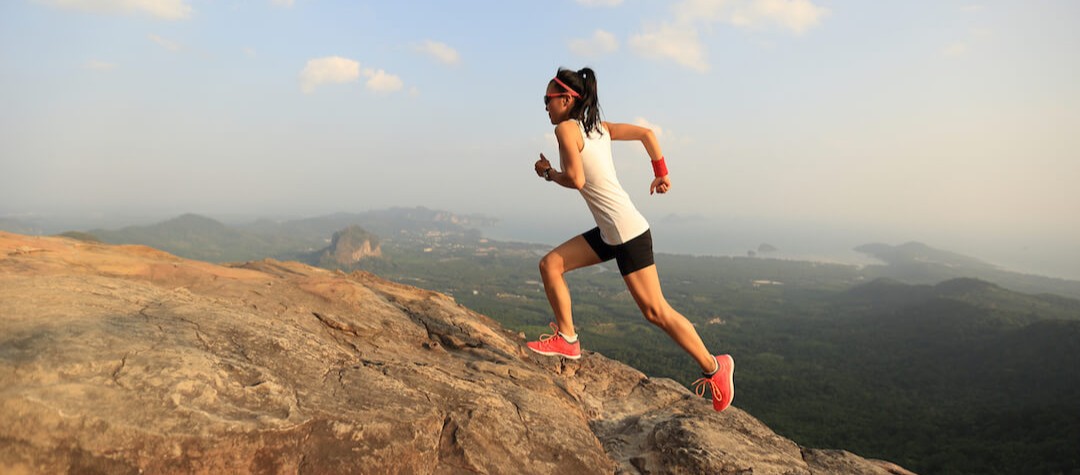Even though everyone has a different running story, whether you’ve been running all of your life or you’re relatively new to the sport, the dreaded plateau affects most runners.
What’s a running plateau? It is the moment when you feel your running isn’t really going anywhere, because you can’t seem to get any faster. But rest assured there are always things you can try to kick-start your efforts. Use these secrets to help you get your PB down.
1. Running on all surfaces/terrains
Running on different surfaces requires different skill sets. You need different muscle strength and balance to negotiate uneven surfaces, which in turn will boost ankle, hamstring and quad strength, core stability and eventually improve your running technique.
You engage muscles you don’t normally use when running on new surfaces and it gives your body a break from the jarring impact of tarmac, as well as the same repetitive gait and stride pattern you experience on a road. Be careful though, running off-road after spending a long time on the flat can be a shock to the system, and it is easy to turn an ankle on a trail.
2. Hill sessions
Hill running is hugely effective at improving your running speed because it develops your stride length and stride frequency. You need smaller strides to go uphill accompanied by a real drive from the knee to propel you upwards. On the descent you need larger more frequent strides, but remember to focus on your technique so that you don’t overstride.
A 12-week Swedish study found that runners who included two hill sessions a week, reduced their 10-mile PB by as much as two minutes, and reduced their marathon PB by up to six minutes.
A 12-week Swedish study found that runners who included two hill sessions a week, reduced their 10-mile PB by as much as two minutes, and reduced their marathon PB by up to six minutes.
When you run again on the flat after a tough session on hills, it will feel much easier. Hills also strengthen key running muscles, like glutes, quads, hamstrings and ankles, which will help with injury prevention. Hill training also strengthens your ankles.
3. Fartlek sessions
Lots of Kenya’s elite runners are great advocates of two types of training. They run a lot of hills and they run a lot of fartlek sessions, which helps to improve their speed. Fartlek, which is Swedish for unstructured interval sessions, means that rather than running at a certain speed for a certain period of time, you vary the speed element of the training session throughout, switching between sprinting, jogging and walking.
Fartlek sessions are a good way of gauging your run by how you feel.
Fartlek sessions are a good way of gauging your run by how you feel. In fact you could ditch the stopwatch altogether and just go for a run based on feel. Try it. You might surprise yourself.
4. Alternate your workouts
Although it is tempting to keep smashing out punishing session after punishing session in pursuit of a new PB, the reality is, it doesn’t necessarily yield results. Tough sessions are essential and with good reason, but you also need to give your body a break and run slower at times, just to enjoy your workout and recover. A slower, less intense run will leave you physically and mentally refreshed, which means when the next tough session comes around you can give it your all.
5. Cross training
Mixing it up on the training front works because it provides body balance. In allowing the major running muscles to have a rest, while strengthening your non-running muscles, it will also help with injury prevention.
Cross training means you can maintain or even improve your cardiovascular fitness, depending on the workout you do, as well as providing a mental break from running. Swimming, cycling, gym workouts, dancing, rowing, elliptical workouts and yoga are just some of the potential options. And whatever you do, when you return to running, you will feel refreshed and ready to go again, and that can only help your training.
6. Running buddy
Running with a friend or part of a group is another great way to push yourself and make the step up to the next level. The beauty of running in company is that it stimulates your competitive edge. If someone is faster than you, you will try and beat them. If you’re the fastest runner, you will try to protect that status by running even quicker. Either way it’s a win-win scenario, plus the fact that you have a shared passion for the sport means you can swap tips and talk training while you run. It all helps.
7. Different time/different place
Boredom can be a factor in running, so keep things fresh by running in other places at alternative times of the day. Another thing you could try is a different training venue. You could be pleasantly surprised by the difference it makes to your training.
8. Change of plan
Runners should always be training to a plan, be that targeting a particular race, or building up to a certain race distance. But if things aren’t working out for you, it might be an idea to try a different training plan or training method.














